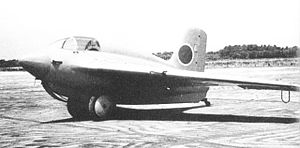| MXY8 Akigusa | |
|---|---|
 | |
| General information | |
| Type | Training Glider |
| National origin | Japan |
| Manufacturer | Yokosuka Naval Air Technical Arsenal |
| History | |
| Variants | Yokosuka MXY9 |
The Yokosuka MXY8 Akigusa (秋草, "Autumn grass") was a training glider built in parallel with the Mitsubishi J8M rocket-powered interceptor aircraft.
Design and development
The J8M was to have simply been a licence-built Messerschmitt Me 163 Komet, but due to difficulties in obtaining technical materials from Germany, it eventually had to be designed almost from scratch. The MXY8 was designed in parallel with the J8M to validate the design, and then to provide pilot training during the development of the actual interceptor. The Army designation for the type was Ku-13.
The MXY8 was built entirely of wood, and fitted with ballast tanks that would be filled with water to simulate the weight and therefore flight characteristics of a fully equipped J8M. Some 50-60 of these gliders were eventually built.
A more advanced trainer, the MXY9, equipped with a primitive jet engine was planned, but was never produced.
Many sources apply the designation MXY8 to the Yokosuka MXY7 Ohka kamikaze weapon.
Specifications

Data from Japanese Aircraft of the Pacific War
General characteristics
- Crew: 1
- Length: 6.05 m (19 ft 10 in)
- Wingspan: 9.5 m (31 ft 2 in)
- Height: 2.7 m (8 ft 10 in)
- Wing area: 17.73 m (190.8 sq ft)
Performance
See also
Related development
References
- Notes
- Francillon 1979, p. 404.
- Francillon 1979, p. 405.
- Francillon 1979, pp. 405–406.
- Francillon 1979, p. 406.
- Francillon 1979, p. 407.
- Bibliography
- Francillon, René J. (1979) . Japanese Aircraft of the Pacific War (2nd ed.). London: Putnam & Company Ltd. ISBN 0-370-30251-6.
| Yokosuka Naval Air Technical Arsenal aircraft | |
|---|---|
| Torpedo bombers | |
| Dive bombers | |
| Reconnaissance seaplanes | |
| Flying boats | |
| Training aircraft | |
| Transport aircraft | |
| Special-purpose aircraft | |
| Bombers | |
| Land-based Reconnaissance | |
| World War II Allied reporting names | |
| Imperial Japanese Navy aircraft designations (short system) | |
|---|---|
| Fighters (A) | |
| Torpedo bombers (B) | |
| Shipboard reconnaissance (C) | |
| Dive bombers (D) | |
| Reconnaissance seaplanes (E) | |
| Observation seaplanes (F) | |
| Land-based bombers (G) | |
| Flying Boats (H) | |
| Land-based Fighters (J) | |
| Trainers (K) | |
| Transports (L) | |
| Special-purpose (M) | |
| Floatplane fighters (N) | |
| Land-based bombers (P) | |
| Patrol (Q) | |
| Land-based reconnaissance (R) | |
| Night fighters (S) | |
| X as second letter is for experimental aircraft or imported technology demonstrators not intended for service, Hyphenated trailing letter (-J, -K, -L, -N or -S) denotes design modified for secondary role, Possibly incorrect designation, but used in many sources | |
| Imperial Japanese Navy official aircraft names | |||||||||
|---|---|---|---|---|---|---|---|---|---|
| Fighters |
| ||||||||
| Heavy bombers | |||||||||
| Bombers | |||||||||
| Patrol | |||||||||
| Reconnaissance | |||||||||
| Trainers | |||||||||
| Transports | |||||||||
| Miscellaneous | |||||||||
| Special-purpose aircraft | |||||||||
| With some exceptions for rockets, jets and repurposed aircraft, names chosen were for: 1. Winds, 2. Lightning, 3. Nighttime lights, 4. Mountains, 5. Stars/constellations, 6. Seas, 7. Clouds, 8. Plants, 9. Skies, 10. Landscapes, and 11. Flowers. Published translations disagree, and many are simplified, especially for plants, where the Japanese referred to a specific variety and the common translations only to the broader type. | |||||||||
| Japanese Army Glider Designation System | |
|---|---|